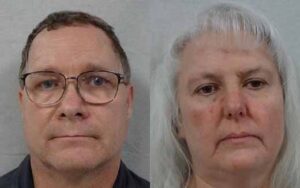
LITTLE ROCK, Ark. (BP)–It began as a two-week music ministry to Europe for 25 members of the Ouachita Singers. It abruptly ended in a crisis ministry amid the fiery crash of American Airlines flight 1420 just beyond the runway at Little Rock National Airport.
Among 145 people on board, nine have been confirmed dead, including James A. Harrison, 21, a member of the choir sponsored by Ouachita Baptist University in Arkadelphia, Ark. Harrison was a senior music major at Ouachita and was minister of music at Royal Baptist Church in Royal, Ark. At least one passenger reported that Harrison helped her to safety prior to his death.
The June 1 crash of flight 1420 from Dallas to Little Rock was the first fatal accident involving a U.S. commercial airline since 1997. Seeking to land at 11:51 p.m. amid torrential rain mixed with lightning, hail and gusting winds, the plane bounced twice on the runway, slid into a landing light structure and split into pieces. Fire broke out as survivors scrambled to exit the wreckage and help one another to safety.
Crash survivor Dave Ozmun, assistant professor of communications at Ouachita, acknowledged “it’s just a shock” that Harrison was among those killed in the tragedy. Affirming that he saw Harrison repeatedly demonstrate “the strength of his commitment and faith” throughout the choir trip, Ozmun added, “He’s with the Lord. He’s out of pain.”
Among 31 people who participated in the Ouachita trip, 25 were on the connecting flight from Dallas to Little Rock, including 19 students and Ozmun. Also on the flight were OBU music professors Charles and Cindy Fuller and their three daughters.
Five members of the Ouachita group were among more than 70 people hospitalized following the crash. Two days later, only two of the five remained hospitalized — the Fullers’ 14-year-old daughter, Rachel, who is in critical condition with severe burns, and Kristin Maddox, a 22-year-old student from Ponca City, Okla., who also suffered burns and is listed in serious condition.
A number of heroic rescue efforts unfolded as survivors recounted the moments immediately following the crash.
Charles Fuller recalled seeing “flames coming from the front of the plane toward us.” Jerking open an emergency exit door and stepping onto the wing, Fuller said, “I got my wife out and began pulling people out until there were no more people in that part of the plane. … I called out three times and there was no response.”
As he moved away from the burning wreckage, Fuller quickly found his wife and two of their daughters and guided them to safety. “I went all the way around the plane and there was my other daughter by herself, wandering around. … I found her by the grace of God.”
Unaware of the extent of her injuries at the time, Fuller said she remains the most critically injured among the Ouachita group. Counting his blessings amid the traumatic chain of events, he said, “I’m thankful that my daughter is alive and has a good chance for survival. I’m thankful that we were able to go to Europe and share the gospel. I’m hopeful that God will bring comfort and healing to those who need it.”
During an interview with Diane Sawyer on “Good Morning America,” Fuller declared, “There are times in life where your faith has to mean something. It can’t be something that you just talk about. It has to be something that empowers you to live life.”
Several Ouachita students also pulled fellow passengers to safety and offered comfort and encouragement as victims huddled in the pouring rain and awaited rescue crews.
“Everybody was amazingly calm,” said Ouachita senior Misha Perkins of Garland, Texas. “After the initial screams, all I heard was the roar of the flames.
“A man grabbed my hand and we ran,” she recalled. “I was almost waist deep in water at one point. We had to jump. There were flames to be dodged as well.”
Realizing that people were still trapped inside the plane, Perkins said, “We began to pray. I remember falling to my knees and crying in my heart and hearing my friend pray and we began to recite Psalm 91. … We began to find more people and formed a cluster. We began to organize who was the most hurt and needed medical attention.”
Sharing that she used her body to try to shield an injured passenger from the weather, Perkins noted, “I felt for a while like I was useless and in the way.” She quickly discovered, however, that “I could put a calming hand on a shoulder, I could offer my body for warmth and I could tell them about Jesus, which ended up doing more good than I thought it could.
“I saw a lot of gentle shepherds among the group,” she emphasized. “I watched people minister and be ministered to.”
“The students handled themselves extremely well,” Ozmun affirmed. “They took the opportunity they had as survivors to be a witness to others.”
Ozmun also was among those who sought to minister to injured victims. Quickly escaping the wreckage, he initially began running from crash site, fearing the plane was going to explode. Despite that fear, he returned to the plane and began helping those in need. “One of the blessings for me was to sit with and talk to and hold hands with those who couldn’t move.
“I felt the Lord’s presence throughout it,” he said. Pointing out that people already were praying for the choir team prior to the crash, he said, “I think that was instrumental in so many of us walking away from it.”
“There were a lot of miracles at work at midnight,” Fuller agreed. “The plane could have gone in the river or the fire could have been much worse. … There’s Somebody greater than we are who is in control. People of Christian faith are able to see life through an eternal perspective.”












